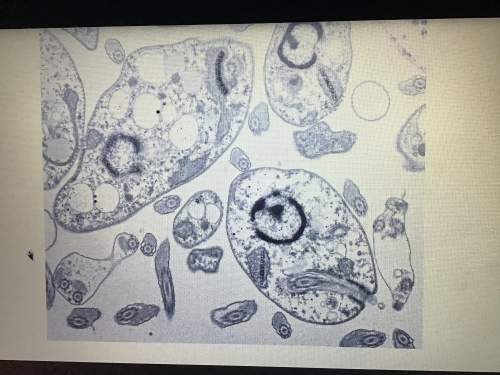1. what do the dark areas in the large cells represent? explain your reasoning.
2. identify t...

Biology, 19.09.2019 09:30 michaeltheballer1
1. what do the dark areas in the large cells represent? explain your reasoning.
2. identify the cells as eukaryotic or prokaryotic, and explain your reasoning.
3. are the cellls able to move on their own? why or why not?
4. are the cells arranged in tissues? why or why not?


Answers: 2


Another question on Biology

Biology, 21.06.2019 20:00
You have been asked to lead a demonstration for the undergraduate microbiology lab course about the uses of negative staining when studying bacteria. a "negative" stain does not stain the bacterial cell itself but stains the space between cells. under magnification, the acidic (negativelycharged) nature of the stain will be repelled by the negatively charged bacterial cell wall and willleave the cell colorless in a stained background. negative stains are used primarily to reveal the presence of negatively charged bacterial capsules; therefore, they are also called capsule stains. encapsulated cells appear to have a halo surrounding them. the negative stain procedure does not require heat fixation, which limits any chances of alteration in bacterial cell shape and size. the bacterial suspension is added to a drop of stain, such as nigrosin or eosin, and drawn across the glass slide using a coverslip.nigrosin staining-not safranin staining-of klebsiella pneumoniae will allow for the visualization of the cell shape and the determination of the presence of a capsule.true/false
Answers: 1

Biology, 22.06.2019 00:00
Which ideas did your answer contain? check all that apply. no food for organisms no oxygen in the atmosphere no trees or flowering plants no products based on trees or plants (building materials, medicines, fuels, fibers) no fossil fuels
Answers: 3

Biology, 22.06.2019 05:10
Hydrilla (hydrilla verticillata) is an invasive aquatic plant and one of the most serious aquatic pests in florida. hydrilla has already been introduced to hundreds of bodies of water throughout florida, hydrilla is difficult to control because it grows rapidly and survives in many different water depths and conditions. hydrilla • describe how hydrilla affects native plant and animal species. include both a biotic and an abiotic limiting factor. • suggest one biotic and one abiotic recommendation that could slow the spread of hydrilla
Answers: 3

Biology, 22.06.2019 07:40
What's the waste product of electrons and pyruvate combining in fermentation?
Answers: 2
You know the right answer?
Questions


Spanish, 01.08.2019 03:30

Arts, 01.08.2019 03:30

Chemistry, 01.08.2019 03:30




Biology, 01.08.2019 03:30

Mathematics, 01.08.2019 03:30



Mathematics, 01.08.2019 03:30

Social Studies, 01.08.2019 03:30



Physics, 01.08.2019 03:30

Computers and Technology, 01.08.2019 03:30






